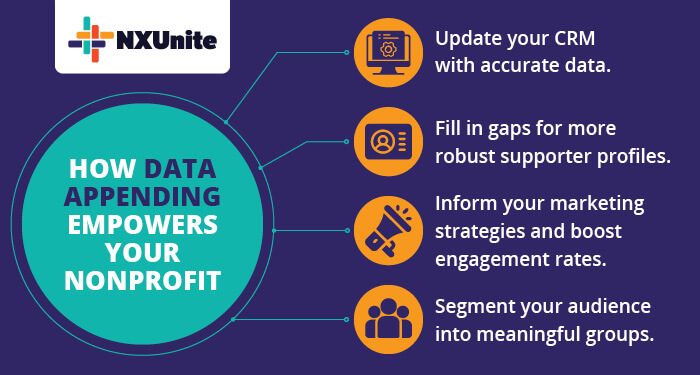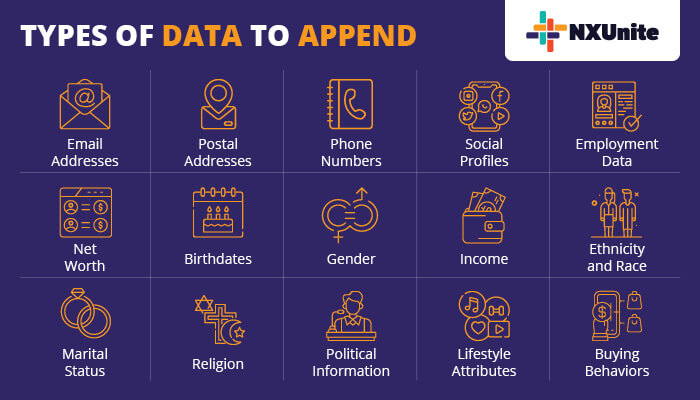Data Append – Nonprofit Catalog
Today’s marketers work with data every day and understand its vital role in maximizing return on investment for outreach. However, inaccurate contact information—among other crucial supporter data—can ultimately waste your team’s time, lead to a decline in supporter engagement, and hold back your team from achieving its mission. That’s where data appends come into play!
In a data-driven world, there’s no excuse for inaccurate data! Modern technology allows any organization to unlock the power of data appending for a relatively low cost. We’ll take a closer look at the basics, so you can start updating your constituents’ profiles and elevate your relationships with those who make your work possible.
What Is a Data Append?
Data appending is the process of adding new data elements to an existing database. Most often used by marketers, data appending allows you to use identifying information to fill in missing constituent data, such as phone numbers, email addresses, and postal addresses.
To append data, you’ll take the information your nonprofit’s collected on individual supporters and match it against a more extensive third-party database. To reduce the manual labor needed, many nonprofits turn to a trustworthy service provider to conduct the data append for them.
How Can Data Appends Help Your Organization?
There are plenty of reasons why you might append data for your nonprofit. For instance, you won’t have to reach out to supporters to update their information continually. Contacting them is time-consuming on both ends and likely won’t yield results.
In addition to streamlining information updates, data appending allows you to:
- Clean up your nonprofit’s data and make sure your CRM isn’t cluttered with outdated or otherwise inaccurate data (such as those caused by typos during manual data entry).
- Fill in gaps for missing information to ensure you have a complete record for each supporter.
- Increase open rates by sending outreach to the correct email addresses, mailing addresses, and phone numbers.
- Identify new segments within your audience so you can tailor your outreach and services to specific groups who share similar demographics.

Ultimately, you just need to decide what types of information you want to append and how doing so will fit into your larger strategies.
What Are the Different Types of Data Appends?
As a nonprofit marketer, you already know there’s an endless list of data you collect for supporters. Knowing this, you’re probably wondering what types of data you can append for individual supporters. What’s more, which types of data are actually worth appending?
Knowing which information will actually propel your marketing efforts forward will help you spend your budget responsibly. While you’ll primarily want to append contact information, there are some other valuable data points you can append, resulting in richer profiles. Let’s explore some of the most common types!

Contact Information Appends
Verify existing contact information and find missing details to make sure you’re reaching out to the right people. Here are some of the most common types of contact information you can append:
- Email addresses. Email marketing is one of the most lucrative digital marketing avenues. Marketing research indicates that for every dollar spent, you can expect an average return of $36. That’s a higher return than any other form of marketing. But to experience those benefits, you’ll want to have the right email addresses for supporters!
- Postal addresses. Even with the rise of digital marketing, direct mail isn’t dead. In fact, it’s a more personal form of communication that can help you steward deeper relationships when compared to mass emails and generic social media posts. People’s mailing addresses change all the time, so continually append postal addresses to keep them up-to-date.
- Phone numbers. Reaching out via text or phone call can be a great way to connect with supporters. Plus, it opens your team up to more fundraising opportunities, like phone banking and text fundraising. Just like mailing addresses, people’s phone numbers change from time to time, too. Use data appending to make sure you have the most recent numbers for supporters.
- Social profiles. With more than 4.2 billion active users, social media is a fantastic way to tap into a global network of supporters. Connect with your current supporters and encourage them to spread the word about your cause by interacting with your team online. Just make sure you have the right social media profiles for them!
If your email bounce rates are high or your call answer rates are low, it might be time to conduct a data append and make sure the information you have on file is accurate!
Employer Appends
An employer append allows you to add employment information for each of your contacts. This is a fantastic way to identify corporate giving opportunities. Double the Donation’s guide to employer appending breaks down a few ways this process can impact your fundraising, such as:
- Uncover corporate giving opportunities. Research each company’s corporate giving guidelines to determine whether you have any available matching gift or volunteer grant opportunities.
- Identify potential corporate partnerships. If several supporters work for the same company, use that information to kickstart a conversation with company leadership. You can even have supporters facilitate introductions with company leadership if they have direct connections.
- Estimate wealth data. Knowing information like where your donors work and what their roles are can help you estimate their incomes and, by extension, their giving abilities.
With the right strategies, appending employer data can help create more robust supporter profiles and can impact your ability to reach your fundraising goals.
Demographic Appends
With this type of data appending, you can pull essential background information about your supporters, which will allow you to segment them into meaningful groups and send highly-tailored outreach.
NPOInfo’s guide to demographic appends lists the following standard demographic information that nonprofits append:
- Net worth
- Age
- Gender
- Ethnicity and race
- Income
- Marital status
- Presence of children
- Religion
- Political affiliation
- Lifestyle attributes such as hobbies, interests, and occupations
- Buying behaviors such as online product purchases and online gift registries
How you leverage this information will depend on your unique organization. For instance, advocacy organizations may want to verify contacts are of voting age or have a certain political affiliation before reaching out.
Birthdate Appends
Dates of birth help you to better understand how to connect with your supporters. When you get creative, you can leverage birthdays to improve supporters’ experiences with your organization. For example, you might use this information to:
- Send birthday newsletters and gifts to donors.
- Encourage supporters to launch a birthday fundraiser on social media where they ask followers to donate to your cause.
- Verify people are of voting age before contacting them about an upcoming election.
- Segment your donors into similar age groups to send targeted communications.
From simply wishing people a happy birthday to encouraging birthday fundraisers, there’s a lot you can do when you know supporters’ birthdays. Pair all the data you append to transform the supporter experience and cultivate stronger, more meaningful relationships.
Additional Resources
Nonprofit Catalog – Read up on more nonprofit essentials by exploring our Nonprofit Catalog.
The Nonprofit’s Ultimate Guide to Data Append Services – Learn the value of data append services and how the process can transform your marketing strategies.
The Data Append Guide for Nonprofits Working on Data Hygiene – Dive further into the data append process and gain plenty of data enrichment tips with this guide.


